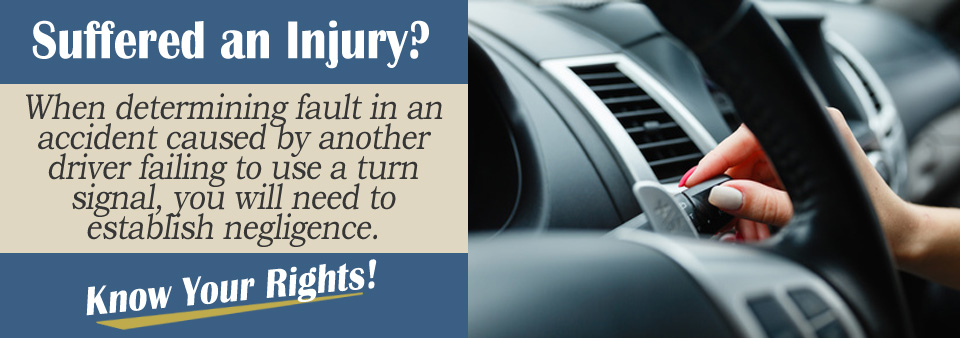If a driver doesn’t use a turn signal and an accident results, you might be left wondering who is at fault. Sometimes it is difficult to determine who is at fault for the resulting crash, but at other times, it is much more obvious.
When the police come to complete the accident report, they will investigate your crash. Oftentimes, the report will indicate who is at fault. While you know that the driver in front of you didn’t use a signal and that contributed to the crash, it could be hard to prove.
There is No Automatic Fault
As an example, you were driving down the road when a car in front of you suddenly starts to turn. The driver failed to use a signal, so you didn’t slow down in time and you hit the car in the rear. You say that if you had known the car was going to turn, you would have done everything that you could have done to avoid a collision.
Usually, when a car is struck from behind, the driver of the car in back is liable for the damages that resulted. The thought behind that is that the car in front cannot force a vehicle from behind to strike them. The car in the back has the responsibility to drive slow enough and stay far enough back that a crash is avoided.
Factors Are Considered
All factors will have to be considered to determine if the car in front contributed to the crash. Did the driver of the vehicle in front slam his or her brakes suddenly, so the car behind him or her had very little warning and no time to stop? Did the driver in front fail to use a turn signal, then suddenly change directions failing to give the driver in the back car enough time to react? Was the driver in the back car driving too fast or too close to stop in time? If the driver had used a signal, would the car in back have been able to react in time and avoid a collision?

The Kinds of Negligence
Whether the state uses comparative or contributory negligence plays a role in the personal injury claim process. Even if you were the driver of the vehicle who rear-ended the front vehicle, your percentage of blame might be reduced significantly by the driver of the front car failing to signal. Therefore, the driver who failed to signal was liable for failing to obey traffic laws and warn traffic of the intent to change direction.
In some states, if the driver is considered at least 50% at fault for a crash for failing to use a signal, you might be able to pursue a personal injury claim against him or her.
Consult With a Personal Injury Attorney
If you have been in an accident where you hit another car because the driver failed to use a signal, you should consult with a personal injury attorney. See if you can pursue a personal injury claim to recover damages. Fill out the free case evaluation form today to be connected with an attorney.